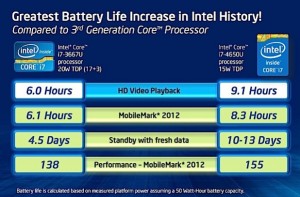Share This
Related Posts
Tags
Intel Haswell
By Erica Rascón on Jun 7, 2013 in Technology
 We’ve blogged before on the shift from PCs and laptops to tablets, a trend that still has momentum at its back. Intel, the world’s leading chip manufacturer for personal computers, has announced the release of a new product that may reasonably swing the balance—or at least level the playing field.
We’ve blogged before on the shift from PCs and laptops to tablets, a trend that still has momentum at its back. Intel, the world’s leading chip manufacturer for personal computers, has announced the release of a new product that may reasonably swing the balance—or at least level the playing field.
Intel’s Haswell chip has been outfitted with several new components that permit faster, more energy efficient operations. As a result, the computers that use the chip can also become faster, greener, and lighter. As a bonus, Haswell machines will also offer improved graphics, less heat generation, and the gift of silence.
Haswell at a Glance
- Microsleeps to save power: “If someone is typing on their PC, we can literally shut everything down when it’s not being used and then immediately bring it back up again in between the keystrokes,” says Navin Shenoy, vice president of the Intel Architecture Group, in an interview with the BBC. “The system is smart enough to know it’s not being used for those nanoseconds. That’s the kind of granular power management at the chip level that we’ve never had before.” This feature promotes longer battery life and less energy drain. Active-use battery life has been reduced by 50%, with inactive battery use improved by 75 percent compared to the previous generation.
- Quieter and cooler: Certain versions of Haswell contain a CPU core that uses six watts of power, which is low enough to ditch a noisy, cumbersome fan. The unit stays cool with less noise.
- Notable leap in GPU: The average user will have no need for an additional graphics card, which previously added to the cost and bulk of PCs. Notebooks and two-in-one devices can now compete with tablets on weight and bulk.
- Increased capability: Haswell’s CPU performance has improved by 15% when compared to its predecessor, Ivy Bridge.
- Affordability to follow: Will we see a $200 super laptop? Perhaps. Bay Trail, the codename in use for a cheaper version of the Haswell, may be on the market soon. It could also be compatible with Android devices.
Game Changer or Too Little, Too Late?
Tablet and smartphone users champion their devices for several factors, mainly value and mobility. Haswell paves the way for laptops and two-in-one devices to become more affordable and more mobile but is it enough?
The tablet revolution is in full swing. According the Gartner forecast, tablet and mobile phone shipments may reach 2.4 billion worldwide in 2013. That’s a 9 percent increase from 2012. In contrast, PC shipments can expect a 7.6 percent decline this year. The robust Haswell may not be enough to get tablet fans back on the PC station wagon.
Chris Green, principal technology analyst at Davies Murphy Group Europe, explains, “They are trying to sell processors for computers into a market where people have increasingly lost interest.” He observes that past innovations with Windows 8, Mac and Linux PCs have been unable to turn the tide. On graphs, PC figures still lurk in the shadows of tablets’ looming profit margins. The tiny Haswell chip is taking on a mighty feat.
A bit of PR could help the chip achieve its goal in the marketplace. Devices operating on Haswell could feasibly change their names and create their own niche; the chip changes the functionality and appearance of the devices so a new name would be in order. Buyers readily transitioned from cellphones to smartphones when the devices could do more. Buyers also welcomed notebooks when their heavy, flesh-searing laptop cousins received a bad rap. Lighter, quieter, greener, smarter device operating with Haswell could surely earn a name for itself while dodging the depressing figures that accompany PC forecasts. What do you think?
